STS-104
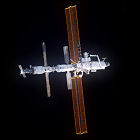 Space Shuttle Atlantis lifts off on the 105th shuttle flight, a 13-day flight to resupply and install new hardware on the International Space Station. The station gains a new airlock and an equipment pallet – formerly part of the Spacelab module – which is attached to the station’s exterior. Aboard Atlantis for her 24th flight are Commander Steven Lindsey, Pilot Charles Hobaugh, and mission specialists Michael Gernhardt, James Reilly and Janet Kavandi.
Space Shuttle Atlantis lifts off on the 105th shuttle flight, a 13-day flight to resupply and install new hardware on the International Space Station. The station gains a new airlock and an equipment pallet – formerly part of the Spacelab module – which is attached to the station’s exterior. Aboard Atlantis for her 24th flight are Commander Steven Lindsey, Pilot Charles Hobaugh, and mission specialists Michael Gernhardt, James Reilly and Janet Kavandi.
Soyuz TM-32: tourism in space
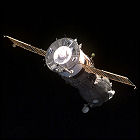 Russia launches Soyuz TM-32 to the International Space Station. Aboard the Soyuz for an eight-day stay on the ISS are cosmonauts Talgat Musabayev and Yuri Baturin, and multi-millionaire space tourist Dennis Tito, the first space traveler to buy his own seat aboard a spacecraft. NASA is less than thrilled with the presence of a “tourist” in space, and refuses to allow Tito to train in advance for activities in the American-built segments of the station. This crew returns to Earth aboard Soyuz TM-31.
Russia launches Soyuz TM-32 to the International Space Station. Aboard the Soyuz for an eight-day stay on the ISS are cosmonauts Talgat Musabayev and Yuri Baturin, and multi-millionaire space tourist Dennis Tito, the first space traveler to buy his own seat aboard a spacecraft. NASA is less than thrilled with the presence of a “tourist” in space, and refuses to allow Tito to train in advance for activities in the American-built segments of the station. This crew returns to Earth aboard Soyuz TM-31.
STS-100: fully armed & operational station
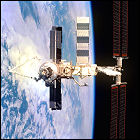 Space Shuttle Endeavour lifts off on the 104th shuttle flight, a 12-day mission to resupply and continue construction of the International Space Station. The primary addition to the station is the Canadian-built remote manipulator arm, derived from the design that has been flown throughout the Space Shuttle program, to be affixed to the station itself. Aboard Endeavour for her 16th flight are Commander Kent Rominger, Pilot Jeff Ashby, and mission specialists Chris Hadfield, Scott Parazynski, John Phillips, Umberto Guidoni and Yuri Lonchakov.
Space Shuttle Endeavour lifts off on the 104th shuttle flight, a 12-day mission to resupply and continue construction of the International Space Station. The primary addition to the station is the Canadian-built remote manipulator arm, derived from the design that has been flown throughout the Space Shuttle program, to be affixed to the station itself. Aboard Endeavour for her 16th flight are Commander Kent Rominger, Pilot Jeff Ashby, and mission specialists Chris Hadfield, Scott Parazynski, John Phillips, Umberto Guidoni and Yuri Lonchakov.
STS-102 / ISS Expedition 2
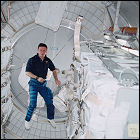 Space Shuttle Discovery lifts off on the 103rd shuttle flight, a mission to exchange crewmembers aboard the International Space Station. In the cargo bay is a logistics module containing consumables, supplies, and equipment racks to be installed in the Destiny laboratory module. Aboard Discovery for her 29th flight are Commander James Wetherbee, Pilot James Kelly, mission specialists Andrew Thomas and Paul Richards, and ISS Expedition 2 crewmembers James Voss, Susan Helms and Yuriy Usachev. The Expedition 1 crewmembers (William Shepherd, Yuri Gidzenko and Sergei Krikalev) return to Earth aboard the shuttle.
Space Shuttle Discovery lifts off on the 103rd shuttle flight, a mission to exchange crewmembers aboard the International Space Station. In the cargo bay is a logistics module containing consumables, supplies, and equipment racks to be installed in the Destiny laboratory module. Aboard Discovery for her 29th flight are Commander James Wetherbee, Pilot James Kelly, mission specialists Andrew Thomas and Paul Richards, and ISS Expedition 2 crewmembers James Voss, Susan Helms and Yuriy Usachev. The Expedition 1 crewmembers (William Shepherd, Yuri Gidzenko and Sergei Krikalev) return to Earth aboard the shuttle.
STS-98: fulfilling Destiny
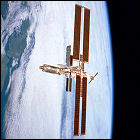 Space Shuttle Atlantis lifts off on the 102nd shuttle flight, a mission to install the American-made Destiny laboratory module on the International Space Station. Once attached to its connection point on the Unity module, Destiny is powered up and pressurized, adding more space for scientific experiments to the station. Aboard Atlantis for her 22nd flight are Commander Kenneth Cockrell, Pilot Mark Polansky, and mission specialists Robert Curbeam, Thomas Jones and Marsha Ivins.
Space Shuttle Atlantis lifts off on the 102nd shuttle flight, a mission to install the American-made Destiny laboratory module on the International Space Station. Once attached to its connection point on the Unity module, Destiny is powered up and pressurized, adding more space for scientific experiments to the station. Aboard Atlantis for her 22nd flight are Commander Kenneth Cockrell, Pilot Mark Polansky, and mission specialists Robert Curbeam, Thomas Jones and Marsha Ivins.
STS-97: increase the power!
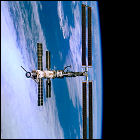 Space Shuttle Endeavour lifts off on an 11-day mission to add a major solar power array to the International Space Station. For the first time, a crew has already arrived via Soyuz and taken up residence on the station prior to the shuttle’s arrival. Another external truss is added, and the first large solar power array – 240 feet long – is added to it, more than quintupling the power available aboard the station. Aboard Endeavour for her 15th flight are Commander Brent Jett, Pilot Michael Bloomfield, and mission specialists Joseph Tanner, Marc Garneau and Carlos Noriega.
Space Shuttle Endeavour lifts off on an 11-day mission to add a major solar power array to the International Space Station. For the first time, a crew has already arrived via Soyuz and taken up residence on the station prior to the shuttle’s arrival. Another external truss is added, and the first large solar power array – 240 feet long – is added to it, more than quintupling the power available aboard the station. Aboard Endeavour for her 15th flight are Commander Brent Jett, Pilot Michael Bloomfield, and mission specialists Joseph Tanner, Marc Garneau and Carlos Noriega.
Soyuz TM-31 / ISS Expedition 1
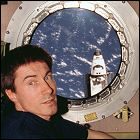 The crew of Soyuz TM-31 spends Halloween in orbit, lifting off from Russia’s Baikonur Cosmodrome on the first long-duration stay aboard the International Space Station. Cosmonauts Yuri Gidzenko and Sergei Krikalev and American astronaut William Shepherd are the first crew to take up residence on the ISS, staying aboard for 136 days. During that stay, they will be visited by the crews of three space shuttles (Endeavour, Atlantis and Discovery), all bringing new hardware modules to the station. This crew returns to Earth aboard Discovery, leaving the Soyuz TM-31 spacecraft as a return vehicle for the next ISS crew.
The crew of Soyuz TM-31 spends Halloween in orbit, lifting off from Russia’s Baikonur Cosmodrome on the first long-duration stay aboard the International Space Station. Cosmonauts Yuri Gidzenko and Sergei Krikalev and American astronaut William Shepherd are the first crew to take up residence on the ISS, staying aboard for 136 days. During that stay, they will be visited by the crews of three space shuttles (Endeavour, Atlantis and Discovery), all bringing new hardware modules to the station. This crew returns to Earth aboard Discovery, leaving the Soyuz TM-31 spacecraft as a return vehicle for the next ISS crew.
STS-92: opening the ISS for business
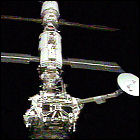 On the 100th flight of the American shuttle program, Space Shuttle Discovery pays a 13-day visit to the International Space Station, making final preparations before the station’s first crew arrives. A new shuttle docking port is added, and the first section of external truss is bolted onto the station, the beginning of a structure that will support the larger solar power panels to be installed during later construction missions. Discovery’s 28th crew is Commander Brian Duffy, Pilot Pam Melroy, and mission specialists Koichi Wakata, Leroy Chiao, Peter Wisoff, Michael Lopez-Alegria and William McArthur.
On the 100th flight of the American shuttle program, Space Shuttle Discovery pays a 13-day visit to the International Space Station, making final preparations before the station’s first crew arrives. A new shuttle docking port is added, and the first section of external truss is bolted onto the station, the beginning of a structure that will support the larger solar power panels to be installed during later construction missions. Discovery’s 28th crew is Commander Brian Duffy, Pilot Pam Melroy, and mission specialists Koichi Wakata, Leroy Chiao, Peter Wisoff, Michael Lopez-Alegria and William McArthur.
STS-106: getting the place ready
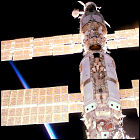 Space Shuttle Atlantis lifts off on the 99th shuttle mission, a 12-day visit to the still-unoccupied International Space Station. Spacewalks and work in the station’s pressurized compartments make the final connections between the Russian-launched Zvezda service module and the rest of the station, and over three tons of supplies – most flown aboard Atlantis, but some contained in an unmanned Progress supply ship which has already automatically docked to the station – are transferred to the station. Atlantis’ 21st crew is Commander Terrence Wilcutt, Pilot Scott Altman, and mission specialists Daniel Burbank, Edward Lu, Richard Mastracchio, Yuri Malenchenko and Boris Morokov. In 2003, Lu and Malenchenko will return as the station’s seventh full-time residents.
Space Shuttle Atlantis lifts off on the 99th shuttle mission, a 12-day visit to the still-unoccupied International Space Station. Spacewalks and work in the station’s pressurized compartments make the final connections between the Russian-launched Zvezda service module and the rest of the station, and over three tons of supplies – most flown aboard Atlantis, but some contained in an unmanned Progress supply ship which has already automatically docked to the station – are transferred to the station. Atlantis’ 21st crew is Commander Terrence Wilcutt, Pilot Scott Altman, and mission specialists Daniel Burbank, Edward Lu, Richard Mastracchio, Yuri Malenchenko and Boris Morokov. In 2003, Lu and Malenchenko will return as the station’s seventh full-time residents.
ISS: Zvezda module launched
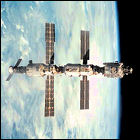 The third major piece of the International Space Station, the Mir-derived Zvezda service module, is launched from Russia. Once in orbit, automatic systems guide Zvezda toward rendezvous and docking with the combined Zarya and Unity modules that currently comprise the station. Zvezda adds life support systems and living quarters, as well as additional power-generating solar panels, to the station, completing the most basic building blocks necessary for ongoing occupation.
The third major piece of the International Space Station, the Mir-derived Zvezda service module, is launched from Russia. Once in orbit, automatic systems guide Zvezda toward rendezvous and docking with the combined Zarya and Unity modules that currently comprise the station. Zvezda adds life support systems and living quarters, as well as additional power-generating solar panels, to the station, completing the most basic building blocks necessary for ongoing occupation.
STS-101
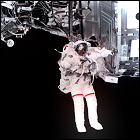 Carrying over 3,000 pounds of supplies for future station crews, Space Shuttle Atlantis lifts off on a ten-day mission to the International Space Station. The supplies include exercise equipment and general housekeeping gear; Atlantis boosts the still-under-construction vacant station’s orbit by 27 miles. Aboard Atlantis for her 20th flight are Commander James Halsell, Pilot Scott “Doc” Horowitz, and mission specialists Mary Ellen Weber, Jeff Williams, James Voss, Susan Helms and Yury Usachev.
Carrying over 3,000 pounds of supplies for future station crews, Space Shuttle Atlantis lifts off on a ten-day mission to the International Space Station. The supplies include exercise equipment and general housekeeping gear; Atlantis boosts the still-under-construction vacant station’s orbit by 27 miles. Aboard Atlantis for her 20th flight are Commander James Halsell, Pilot Scott “Doc” Horowitz, and mission specialists Mary Ellen Weber, Jeff Williams, James Voss, Susan Helms and Yury Usachev.
STS-96: ISS under construction
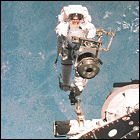 NASA launches Space Shuttle Discovery on the first of only three 1999 shuttle flights, a ten-day mission to continue preparing the International Space Station for full-time duty. 80 hours are spent inside the station, transferring supplies into the existing modules for future crews, and spacewalks are conducted to perform necessary tasks outside the station. Aboard Discovery for her 26th flight are Commander Kent Rominger, Pilot Rick Husband, and mission specialists Ellen Ochoa, Tammy Jernigan, Daniel Barry, Julie Payette and Valery Tokarev.
NASA launches Space Shuttle Discovery on the first of only three 1999 shuttle flights, a ten-day mission to continue preparing the International Space Station for full-time duty. 80 hours are spent inside the station, transferring supplies into the existing modules for future crews, and spacewalks are conducted to perform necessary tasks outside the station. Aboard Discovery for her 26th flight are Commander Kent Rominger, Pilot Rick Husband, and mission specialists Ellen Ochoa, Tammy Jernigan, Daniel Barry, Julie Payette and Valery Tokarev.
ISS: Unity node arrives
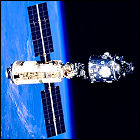 Space Shuttle Endeavour joins the first two modules of the International Space Station together, having carried the Unity docking node into orbit in its cargo bay. With no living quarters or long-term life support facilities, the station is not yet ready for full-time occupancy; two further shuttle missions are required to prepare the station for its next major addition.
Space Shuttle Endeavour joins the first two modules of the International Space Station together, having carried the Unity docking node into orbit in its cargo bay. With no living quarters or long-term life support facilities, the station is not yet ready for full-time occupancy; two further shuttle missions are required to prepare the station for its next major addition.
STS-88: laying the ISS cornerstone
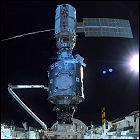 Space Shuttle Endeavour lifts off to begin the construction of the International Space Station. Endeavour conducts a rendezvous with the already-launched Zarya module and attached the Unity station module to it. The two modules’ external connections are completed during a spacewalk, and the station is powered up for the first time on December 7th. Endeavour’s 13th crew is Commander Robert Cabana, Pilot Frederick Sturckow, and mission specialists Nancy Currie, Jerry Ross, James Newman and Sergei Krikalev. Cabana and Krikalev are the first humans to enter the International Space Station, but since the fledgeling facility lacks long-term habitation facilities, it is left unmanned at the end of the 12 day mission.
Space Shuttle Endeavour lifts off to begin the construction of the International Space Station. Endeavour conducts a rendezvous with the already-launched Zarya module and attached the Unity station module to it. The two modules’ external connections are completed during a spacewalk, and the station is powered up for the first time on December 7th. Endeavour’s 13th crew is Commander Robert Cabana, Pilot Frederick Sturckow, and mission specialists Nancy Currie, Jerry Ross, James Newman and Sergei Krikalev. Cabana and Krikalev are the first humans to enter the International Space Station, but since the fledgeling facility lacks long-term habitation facilities, it is left unmanned at the end of the 12 day mission.
ISS: Zarya module launched
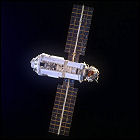 The orbital construction of the International Space Station formally begins with the launch, via a Russian Proton rocket, of the Zarya module. A direct descendant of the core module of the Mir space station, Zarya provides docking access, the station’s first set of solar power panels, and storage. The second component of the station is due to be launched shortly afterward via Space Shuttle.
The orbital construction of the International Space Station formally begins with the launch, via a Russian Proton rocket, of the Zarya module. A direct descendant of the core module of the Mir space station, Zarya provides docking access, the station’s first set of solar power panels, and storage. The second component of the station is due to be launched shortly afterward via Space Shuttle.
International Space Station narrowly avoids cancellation
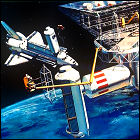 Despite plans having recently been expanded with international partnerships, including the Russian space program, the International Space Station comes within a single vote of being cancelled altogether in the United States House of Representatives. The measure to cancel the program is added to NASA’s authorization bill, which comes up for an annual vote; the measure is brought to the House floor by Indiana Democratic Rep. Tim Roemer and New Jersey Republican Rep. Richard Zimmer. Opposition to the space station comes in the form of budget concerns (the $9,000,000,000 already run up in research and construction is more than the total NASA expected to spend when it was directed to build, launch, and staff the station during the Reagan administration). Opponents of the station keep up their attempts to cancel it, however; a vote is later held for a bill that would strip NASA of station funding, effectively ending the program, and that vote also fails. The program survives by a wider margin in a later Senate vote as well. The same session of Congress does prove to be the end of another major scientific endeavour, the Superconducting Supercollider project already under construction in Texas.
Despite plans having recently been expanded with international partnerships, including the Russian space program, the International Space Station comes within a single vote of being cancelled altogether in the United States House of Representatives. The measure to cancel the program is added to NASA’s authorization bill, which comes up for an annual vote; the measure is brought to the House floor by Indiana Democratic Rep. Tim Roemer and New Jersey Republican Rep. Richard Zimmer. Opposition to the space station comes in the form of budget concerns (the $9,000,000,000 already run up in research and construction is more than the total NASA expected to spend when it was directed to build, launch, and staff the station during the Reagan administration). Opponents of the station keep up their attempts to cancel it, however; a vote is later held for a bill that would strip NASA of station funding, effectively ending the program, and that vote also fails. The program survives by a wider margin in a later Senate vote as well. The same session of Congress does prove to be the end of another major scientific endeavour, the Superconducting Supercollider project already under construction in Texas.
The International Space Station
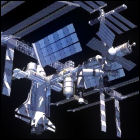 Having drawn the European Space Agency and Japan into partnerships for the still-on-the-drawing-board Space Station Freedom project, NASA announces that it is reaching out to post-Soviet Russia, not just for ideas and engineering expertise, but to become partners in the new space station. With already-built modules sitting on the ground for a Mir 2 station that it cannot afford to launch and operate on its own, Russia becomes a full partner in what will now become the International Space Station. Plans are accelerated for proposed missions to dock the Space Shuttle to the existing Mir space station, and to use Russian Soyuz capsules for crew transfer and return.
Having drawn the European Space Agency and Japan into partnerships for the still-on-the-drawing-board Space Station Freedom project, NASA announces that it is reaching out to post-Soviet Russia, not just for ideas and engineering expertise, but to become partners in the new space station. With already-built modules sitting on the ground for a Mir 2 station that it cannot afford to launch and operate on its own, Russia becomes a full partner in what will now become the International Space Station. Plans are accelerated for proposed missions to dock the Space Shuttle to the existing Mir space station, and to use Russian Soyuz capsules for crew transfer and return.
Space Station Fred
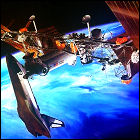 At the insistence of Congress, NASA submits a significant redesign of the long-overdue and over-budget Space Station Freedom for approval. Where previous design changes tried to retain a massive “dual keel” allowing for experiment modules and other activities that could be performed a safe distance away from the station’s habitation modules, the new Space Station Freedom clusters all of its modules together in one place and removes the dual keel structure permanently. Scoffing at the truncated new design, critics refer to the newly-submitted proposal as “Space Station Fred” instead of “Space Station Freedom”.
At the insistence of Congress, NASA submits a significant redesign of the long-overdue and over-budget Space Station Freedom for approval. Where previous design changes tried to retain a massive “dual keel” allowing for experiment modules and other activities that could be performed a safe distance away from the station’s habitation modules, the new Space Station Freedom clusters all of its modules together in one place and removes the dual keel structure permanently. Scoffing at the truncated new design, critics refer to the newly-submitted proposal as “Space Station Fred” instead of “Space Station Freedom”.
Space Station Freedom’s new mission
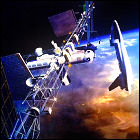 President Reagan approves a $10,000,000,000 budget for a redesigned, pared-down Space Station Freedom, to be constructed over sixteen Space Shuttle launches beginning in 1994, with Freedom not being fully operational until 1996. To the stern disapproval of the scientific community, almost all laboratory space has been removed from Freedom’s design proposal, leaving only Japan and the European Space Agency to provide lab space. Without the space for American astronauts to conduct scientific experiments, Space Station Freedom’s new primary mission is quite clearly stated to be to catch the American space program up with, or surpass, the Soviet Union’s long-duration space missions aboard the Mir space station. While the Preisdent approves of the slimmed-down station design, NASA must now run the gauntlet to get Congressional approval to proceed.
President Reagan approves a $10,000,000,000 budget for a redesigned, pared-down Space Station Freedom, to be constructed over sixteen Space Shuttle launches beginning in 1994, with Freedom not being fully operational until 1996. To the stern disapproval of the scientific community, almost all laboratory space has been removed from Freedom’s design proposal, leaving only Japan and the European Space Agency to provide lab space. Without the space for American astronauts to conduct scientific experiments, Space Station Freedom’s new primary mission is quite clearly stated to be to catch the American space program up with, or surpass, the Soviet Union’s long-duration space missions aboard the Mir space station. While the Preisdent approves of the slimmed-down station design, NASA must now run the gauntlet to get Congressional approval to proceed.
President Reagan commits to space station
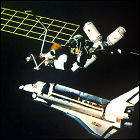 As part of his annual State of the Union address, President Ronald Reagan commits NASA’s resources to building a space station in Earth orbit using the unique space cargo delivery and construction/repair capabilities of NASA’s Space Shuttle fleet. The space agency draws up various plans for stations of varying sizes, ranging from not much bigger than the Apollo/Saturn-derived Skylab of the 1970s to an eventual proposal for a large, “dual keel” design that could become home base for lunar and planetary exploration. All of the proposals, with their multi-billion-dollar cost estimates, instantly find opponents in Congress: the road to a permanently crewed space station will be a long one.
As part of his annual State of the Union address, President Ronald Reagan commits NASA’s resources to building a space station in Earth orbit using the unique space cargo delivery and construction/repair capabilities of NASA’s Space Shuttle fleet. The space agency draws up various plans for stations of varying sizes, ranging from not much bigger than the Apollo/Saturn-derived Skylab of the 1970s to an eventual proposal for a large, “dual keel” design that could become home base for lunar and planetary exploration. All of the proposals, with their multi-billion-dollar cost estimates, instantly find opponents in Congress: the road to a permanently crewed space station will be a long one.
An international space station?
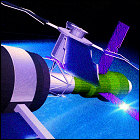 With planning already well underway for the Apollo-Soyuz mission which won’t take place until 1975, NASA commissions a study from McDonnell Douglas to explore the feasibility of a follow-up to the international space mission, possibly involving joining the backup of the Skylab space station (known as “Skylab B”) and a yet-to-be-launched Soviet Salyut space station at some point in the latter half of the 1970s, effectively creating a joint international space station. Although the study goes so far as to specify issues of concern regarding the structure of the two stations and their respective standard atmospheric pressures, the recommendations are shelved pending the outcome of the Apollo-Soyuz flight. Significant political developments in the late 1970s will prevent the idea of an international station from moving forward for at least a quarter century.
With planning already well underway for the Apollo-Soyuz mission which won’t take place until 1975, NASA commissions a study from McDonnell Douglas to explore the feasibility of a follow-up to the international space mission, possibly involving joining the backup of the Skylab space station (known as “Skylab B”) and a yet-to-be-launched Soviet Salyut space station at some point in the latter half of the 1970s, effectively creating a joint international space station. Although the study goes so far as to specify issues of concern regarding the structure of the two stations and their respective standard atmospheric pressures, the recommendations are shelved pending the outcome of the Apollo-Soyuz flight. Significant political developments in the late 1970s will prevent the idea of an international station from moving forward for at least a quarter century.